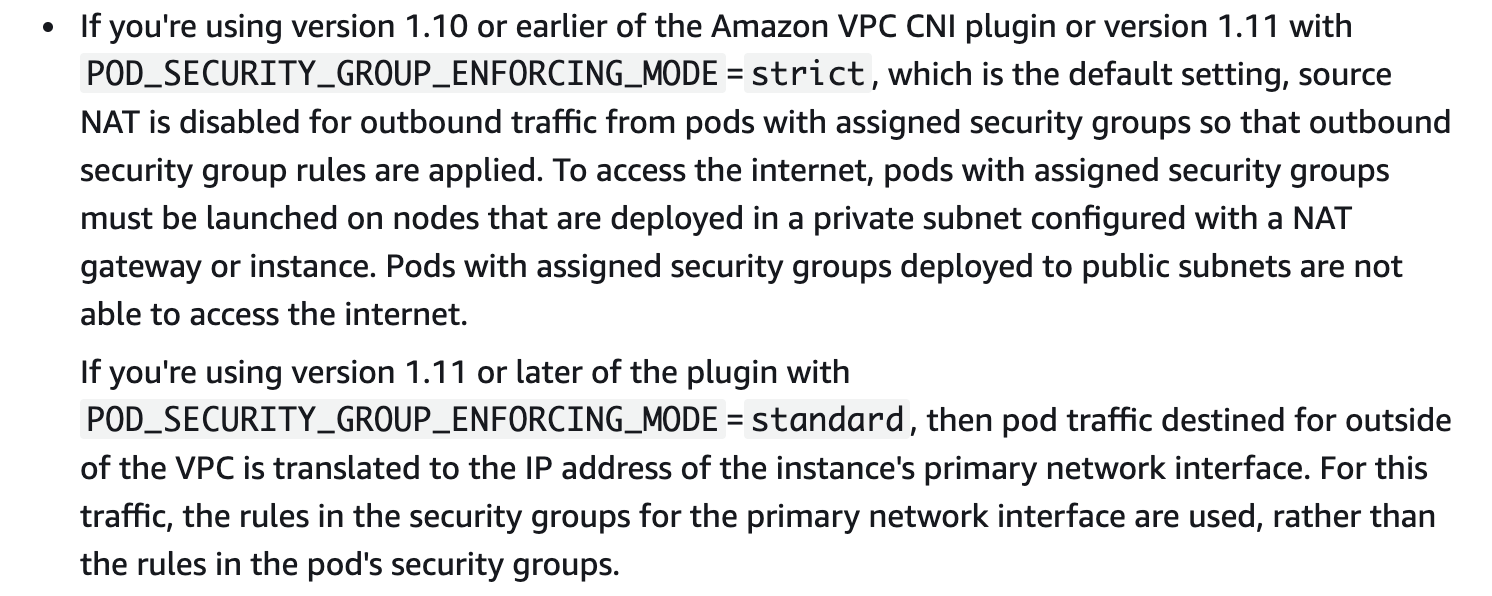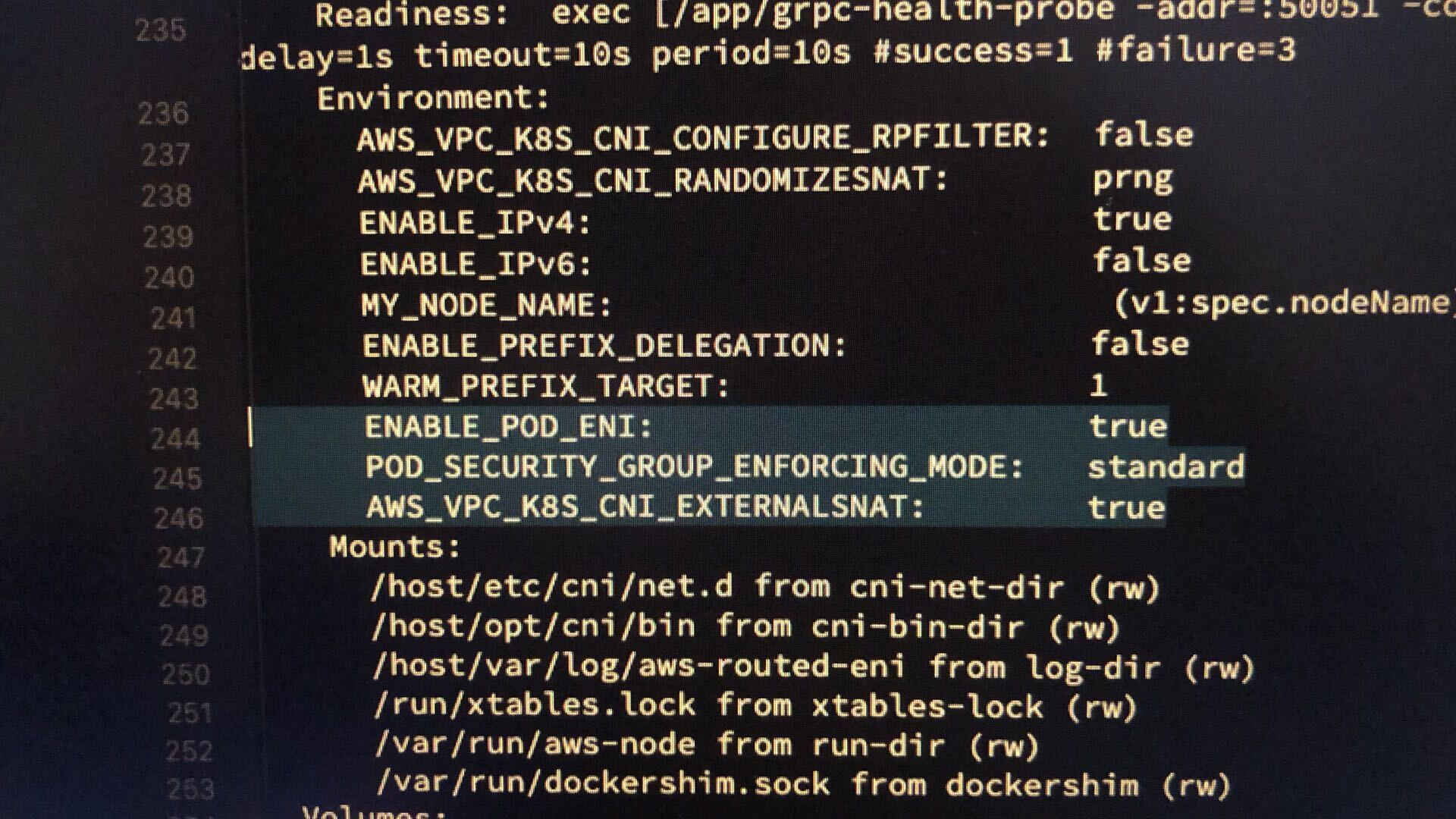enable-sg-on-pod¶
useful-env-sg-on-pod¶
considerations
https://docs.amazonaws.cn/en_us/eks/latest/userguide/security-groups-for-pods.html
第一个参数允许pod 挂sg
第二个参数允许有sg的pod同时遵守network policy控制
第三个参数snat disable,允许跨vpc保留pod ip,不会转成primary eni ip (../../addons/eks-external-snat)
kubectl -n kube-system set env daemonset aws-node ENABLE_POD_ENI=true
kubectl -n kube-system set env daemonset aws-node POD_SECURITY_GROUP_ENFORCING_MODE=standard
kubectl -n kube-system set env daemonset aws-node AWS_VPC_K8S_CNI_EXTERNALSNAT=true
kubectl -n kube-system rollout status ds aws-node
more explanation for ENV on vpc cni github
workshop¶
https://www.eksworkshop.com/beginner/115_sg-per-pod/
-
create SG
CLUSTER_NAME=ekscluster1 export VPC_ID=$(aws eks describe-cluster \ --name ${CLUSTER_NAME} \ --query "cluster.resourcesVpcConfig.vpcId" \ --output text) # create the POD security group aws ec2 create-security-group \ --description 'POD SG' \ --group-name 'POD_SG' \ --vpc-id ${VPC_ID} # save the security group ID for future use export POD_SG=$(aws ec2 describe-security-groups \ --filters Name=group-name,Values=POD_SG Name=vpc-id,Values=${VPC_ID} \ --query "SecurityGroups[0].GroupId" --output text) echo "POD security group ID: ${POD_SG}" -
for managed node group, allow DNS ingress
NODE_GROUP_SG=$(aws ec2 describe-security-groups \ --filters Name=tag:Name,Values=eks-cluster-sg-${CLUSTER_NAME}-* Name=vpc-id,Values=${VPC_ID} \ --query "SecurityGroups[0].GroupId" \ --output text) echo "Node Group security group ID: ${NODE_GROUP_SG}" # allow POD_SG to connect to NODE_GROUP_SG using TCP 53 aws ec2 authorize-security-group-ingress \ --group-id ${NODE_GROUP_SG} \ --protocol tcp \ --port 53 \ --source-group ${POD_SG} # allow POD_SG to connect to NODE_GROUP_SG using UDP 53 aws ec2 authorize-security-group-ingress \ --group-id ${NODE_GROUP_SG} \ --protocol udp \ --port 53 \ --source-group ${POD_SG} -
for unmanaged node group created by
eksctl, allow DNS ingress
# eksctl-ekscluster1-nodegroup-ng1-SG-1XX82XXXXXX5Y) UNMANAGED_NODE_GROUP_SG=$(aws ec2 describe-security-groups \ --filters Name=tag:Name,Values=eksctl-${CLUSTER_NAME}-nodegroup-* Name=vpc-id,Values=${VPC_ID} \ --query "SecurityGroups[0].GroupId" \ --output text) echo "UNMANAGED Node Group security group ID: ${UNMANAGED_NODE_GROUP_SG}" # allow POD_SG to connect to NODE_GROUP_SG using TCP 53 aws ec2 authorize-security-group-ingress \ --group-id ${UNMANAGED_NODE_GROUP_SG} \ --protocol tcp \ --port 53 \ --source-group ${POD_SG} # allow POD_SG to connect to NODE_GROUP_SG using UDP 53 aws ec2 authorize-security-group-ingress \ --group-id ${UNMANAGED_NODE_GROUP_SG} \ --protocol udp \ --port 53 \ --source-group ${POD_SG} -
CNI config
kubectl -n kube-system set env daemonset aws-node ENABLE_POD_ENI=true
kubectl -n kube-system set env daemonset aws-node AWS_VPC_K8S_CNI_EXTERNALSNAT=true
kubectl -n kube-system set env daemonset aws-node POD_SECURITY_GROUP_ENFORCING_MODE=standard
kubectl -n kube-system rollout status ds aws-node
kubectl get nodes --show-labels
# will see `vpc.amazonaws.com/has-trunk-attached=true`
-
create resources (if you create resource on fargate, see below)
# check CRDs existed kubectl get crd securitygrouppolicies.vpcresources.k8s.aws envsubst > ./sg-policy.yaml <<-EoF apiVersion: vpcresources.k8s.aws/v1beta1 kind: SecurityGroupPolicy metadata: name: allow-rds-access spec: podSelector: matchLabels: app: echoserver securityGroups: groupIds: - ${POD_SG} EoF k create ns echo1 k apply -f sg-policy.yaml -n echo1 k apply -f deployment-service.yaml -n echo1 k apply -f ingress1.yaml -n echo1 k create ns echo2 k apply -f sg-policy.yaml -n echo2 k apply -f deployment-service.yaml -n echo2 k apply -f ingress2.yaml -n echo2 k create ns echo3 k apply -f deployment-service.yaml -n echo3 k apply -f ingress3.yaml -n echo3 -
echoserver deployment & service
cat > ./deployment-service.yaml <<-EoF --- apiVersion: apps/v1 kind: Deployment metadata: name: echoserver spec: selector: matchLabels: app: echoserver replicas: 1 template: metadata: labels: app: echoserver spec: containers: - image: k8s.gcr.io/e2e-test-images/echoserver:2.5 imagePullPolicy: Always name: echoserver ports: - containerPort: 8080 --- apiVersion: v1 kind: Service metadata: name: echoserver spec: ports: - port: 80 targetPort: 8080 protocol: TCP type: NodePort selector: app: echoserver EoF -
echoserver ingress for echo1
- echoserver ingress for echo2
-
echoserver ingress for echo3
refer awslbc-ingress-settings-ingress-group -
resource yaml for pod on fargate

